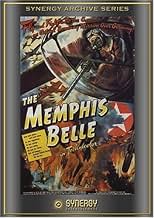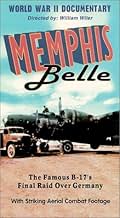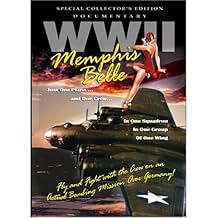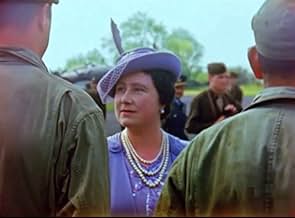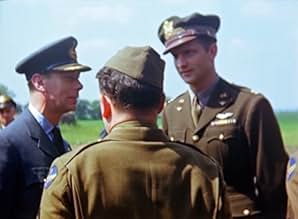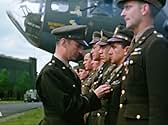Le Memphis Belle, histoire d'une forteresse volante
Original title: The Memphis Belle: A Story of a Flying Fortress
IMDb RATING
7.4/10
2K
YOUR RATING
A documentary on the 25th bombing mission of the Memphis Belle, a B-17 in the US 8th Air Force.A documentary on the 25th bombing mission of the Memphis Belle, a B-17 in the US 8th Air Force.A documentary on the 25th bombing mission of the Memphis Belle, a B-17 in the US 8th Air Force.
- Director
- Writers
- Stars
- Awards
- 4 wins total
Stanley Wray
- Self - Group Commander
- (as Col. Stanley Wray)
Robert Morgan
- Self - Pilot
- (as Capt. Robert Morgan)
James A. Verinis
- Self - Co-Pilot
- (as Capt. Jim Verinis)
Robert J. Hanson
- Self - Radio Operator
- (as Sgt. Bob Hanson)
Charles B. Leighton
- Self - Navigator
- (as Capt. Chuck Leighton)
Harold P. Loch
- Self - Engineer and Top Turret Gunner
- (as Sgt. Harold Loch)
John P. Quinlan
- Self - Tail Gunner
- (as Sgt. John Quinlan)
Cecil H. Scott
- Self - Turret Gunner
- (as Sgt. Cecil Scott)
Vince Evans
- Self - Bombardier
- (as Captain Vincent Evans)
Clarence E. Winchell
- Self - Waist Gunner
- (as Sergeant Bill Winchell)
Casimer A. Nastal
- Self - Waist Gunner
- (as Sergeant Tony Nastal)
Haywood Hansell
- Self - USAAF
- (as Brigadier General Hansell)
Ira C. Eaker
- Self - Commander: 8th Air Force
- (as General Eaker)
Jacob L. Devers
- Self - U.S. Commander: European Theatre
- (as General Devers)
- Director
- Writers
- All cast & crew
- Production, box office & more at IMDbPro
Featured reviews
The pilot was 24-year-old Captain Robert K. Morgan from Asheville, North Carolina who was an industrial engineer before joining the Army in 1941; the co-pilot, whom Captain Morgan insisted was "the other pilot', was 25-year-old Captain James A. Verinis from New Haven, Connecticut, who was a business administration student at the University of Connecticut before entering the service in July of 1941; Captain Vincent B. Evans, the 23-year-old bombadier was one of the two married members of the crew, and was a fleet-truck operator in his home town of Fort Worth, Texas before enlisting in January of 1942; Captain Charles B. Leighton, from East Lansing,Michigan and a chemistry student at Ohio Wesleyan before entering the service, was the navigator. The engineer and top turret gunner was Technical Sergeant Harold P.Loch, a 23-year-old stevedore from Green Bay, Wisconsin who joined the service in November of 1941; Technical Sergeant Robert J.Hanson, a construction worker from Washington state and the other married crew member, was the radio operator. The 19-year-old "baby" of the Memphis Belle crew was waist-gunner Staff Sergeant Casimer A. Nastal who was a washing machine repairman from Detroit, Michigan with two confirmed fighter kills to his credit who thought he had more "but never had time to watch whether they went down"; Staff Sergeant Cecil H. Scott, a pressman for a rubber company in Rahway, New Jersey was the ball turret gunner and, at 27, the oldest member of the crew. One of the three cameraman was First Lieutenant Harold J. Tannenbaum, from Binghamton,New York, a World War I veteran who remained in the Navy until 1927. He re-entered the service in July,1942 when he received his commission in the Army Air Force. He was killed in action,age 46,in April of 1944 and received a posthumous Purple Heart.
William Wyler's Memphis Belle: A Story of a Flying Fortress featuring rare color film of WW 2 is another outstanding Why We Fight Documentary showcasing a B-17 and it's crew on its final bombing run over Germany. In this brief doc Wyler not only captures some of the most harrowing air combat footage in history but also gives us an outstanding overview of what it takes to mount a bombing raid, recognizing the importance of all involved, the shared bond of a diverse group.
Some of the outstanding camerawork in the tight confines of the fortress puts you in the waist gunner position with a Messerschmitt, guns blazing roars at you while ominous flak explodes around "Belle" the chaos verbalized over headsets.
Well edited in displaying the might of the Allies and the stoic resolve and everyday courage of its military "Memphis Belle" is more than just propaganda and an outstanding document of WW2 but a gripping suspense with a lot more on the line than a fiction.
Some of the outstanding camerawork in the tight confines of the fortress puts you in the waist gunner position with a Messerschmitt, guns blazing roars at you while ominous flak explodes around "Belle" the chaos verbalized over headsets.
Well edited in displaying the might of the Allies and the stoic resolve and everyday courage of its military "Memphis Belle" is more than just propaganda and an outstanding document of WW2 but a gripping suspense with a lot more on the line than a fiction.
This Memphis Belle is the real thing, and will be remembered long after the 1990 movie version has been forgotten. It is a documentary filmed during the height of World War II on a USAAF air base in Britain, and also on board the Memphis Belle, a typical B-17 Flying Fortress of the U.S. Army's 8th Air Force.
No blue screens were used in the production of this movie, no Hollywood special effects or computer-generated imaging. William Wyler and his cameramen accompanied the bomber crew on a actual combat missions over Germany. No actors or stunt men were used, either. The men shown flying in the Memphis Belle were the actual crew of the Memphis Belle. In addition, the wounded airmen seen being removed from returning planes were not extras, they really were wounded.
Another aspect of this film that was not faked was the severe battle damage seen on some of the returning B-17s. The fact that some of those planes even managed to get back at all is almost incredible, and the images in this movie stand as a testament both to the skill of the pilots and to the structural integrity of the legendary "Flying Fortress".
The combat footage used in this movie was so good that, for decades, it was used in any movie or television program concerning the air war over Europe, in preference to anything that the Hollywood special effects departments could manufacture. You will see clips from The Memphis Belle in such well-known Hollywood films as "12 O'Clock High" and "Command Decision".
The Memphis Belle is a must-see, both as a tribute to the courageous airmen memorialized in it, and to the intrepid cameramen who literally risked their lives to film it.
No blue screens were used in the production of this movie, no Hollywood special effects or computer-generated imaging. William Wyler and his cameramen accompanied the bomber crew on a actual combat missions over Germany. No actors or stunt men were used, either. The men shown flying in the Memphis Belle were the actual crew of the Memphis Belle. In addition, the wounded airmen seen being removed from returning planes were not extras, they really were wounded.
Another aspect of this film that was not faked was the severe battle damage seen on some of the returning B-17s. The fact that some of those planes even managed to get back at all is almost incredible, and the images in this movie stand as a testament both to the skill of the pilots and to the structural integrity of the legendary "Flying Fortress".
The combat footage used in this movie was so good that, for decades, it was used in any movie or television program concerning the air war over Europe, in preference to anything that the Hollywood special effects departments could manufacture. You will see clips from The Memphis Belle in such well-known Hollywood films as "12 O'Clock High" and "Command Decision".
The Memphis Belle is a must-see, both as a tribute to the courageous airmen memorialized in it, and to the intrepid cameramen who literally risked their lives to film it.
1943 and the allied bombing campaign is at its peak. The Memphis Belle is a B-17 "Flying Fortress" bomber in the US 8th Air Force. Its crew have completed 24 missions - one more and they go home. A documentary film crew captured their 25th mission, from preparation on the ground onwards.
Superb documentary, directed by William Wyler. Captures very accurately the day-to-day lives of US bomber crews in Europe, including the dangers and sacrifices made. Good detail of the mission itself.
Great footage, shot specifically for the documentary. The lives of the documentary crew were also in danger...
Narration is stirring and brings home the importance of the bombers' roles, as well as how endangered the crews' lives were. Very sobering and emotional.
The documentary inspired the great 1990 feature film, Memphis Belle.
Superb documentary, directed by William Wyler. Captures very accurately the day-to-day lives of US bomber crews in Europe, including the dangers and sacrifices made. Good detail of the mission itself.
Great footage, shot specifically for the documentary. The lives of the documentary crew were also in danger...
Narration is stirring and brings home the importance of the bombers' roles, as well as how endangered the crews' lives were. Very sobering and emotional.
The documentary inspired the great 1990 feature film, Memphis Belle.
This is a documentary made by the US Army Air Corps and directed by William Wyler during WWII and. It features the plane and crew of the Memphis Belle—the first bomber to complete its tour of duty successfully. Because of its successes and luck, the bomber and crew were eventually returned to the US for a bond-raising tour. This film was made to coincide with this.
A few things will probably strike you as you watch. First, it is (unlike most films of the day) in color—albeit a bit grainy and washed out. Second, the narration is very grim and direct—non-romanticized all the way. As for the film itself, it's a delight to air buffs as it not only shows footage of the bomber but shows it in action, explains bombing runs and other technical information. It even shows footage of bombers being shot down and damage to the bombers. Clearly this is not just another gung-ho propaganda film but one that stresses realism above all. As a result of these factors, this is a great film—one that is gripping even when seen today.
A few things will probably strike you as you watch. First, it is (unlike most films of the day) in color—albeit a bit grainy and washed out. Second, the narration is very grim and direct—non-romanticized all the way. As for the film itself, it's a delight to air buffs as it not only shows footage of the bomber but shows it in action, explains bombing runs and other technical information. It even shows footage of bombers being shot down and damage to the bombers. Clearly this is not just another gung-ho propaganda film but one that stresses realism above all. As a result of these factors, this is a great film—one that is gripping even when seen today.
Did you know
- TriviaPilot Robert Morgan named the aircraft after his girlfriend at the time, Margaret Polk, of Memphis, TN. Morgan chose the nose artwork from a 1941 illustration in "Esquire" magazine by famous pin-up artist George Petty. She is wearing a blue outfit on the port (left) side of the aircraft and a red one on the starboard (right) side.
- GoofsAs the Forts return to their base, one is shown with its rudder and a good chunk of the fin blown away. In the closeups on the ground, what's left of the tail number reads backward, showing that the film for those scenes was flipped right/left. That plane is 41-9020, which was reassigned as a target tug 32 days before Memphis Belle flew her 25th mission.
- Crazy creditsAll aerial combat film was exposed during air battles over enemy territory
- ConnectionsEdited into Target for Today (1944)
Details
- Release date
- Country of origin
- Language
- Also known as
- Bajo cielos enemigos
- Filming locations
- RAF Bassingbourn, Bassingbourn, Cambridgeshire, England, UK(ground shots; home of 91st BG in the US 8th AF)
- Production companies
- See more company credits at IMDbPro
- Runtime45 minutes
- Sound mix
- Aspect ratio
- 1.37 : 1
Contribute to this page
Suggest an edit or add missing content


